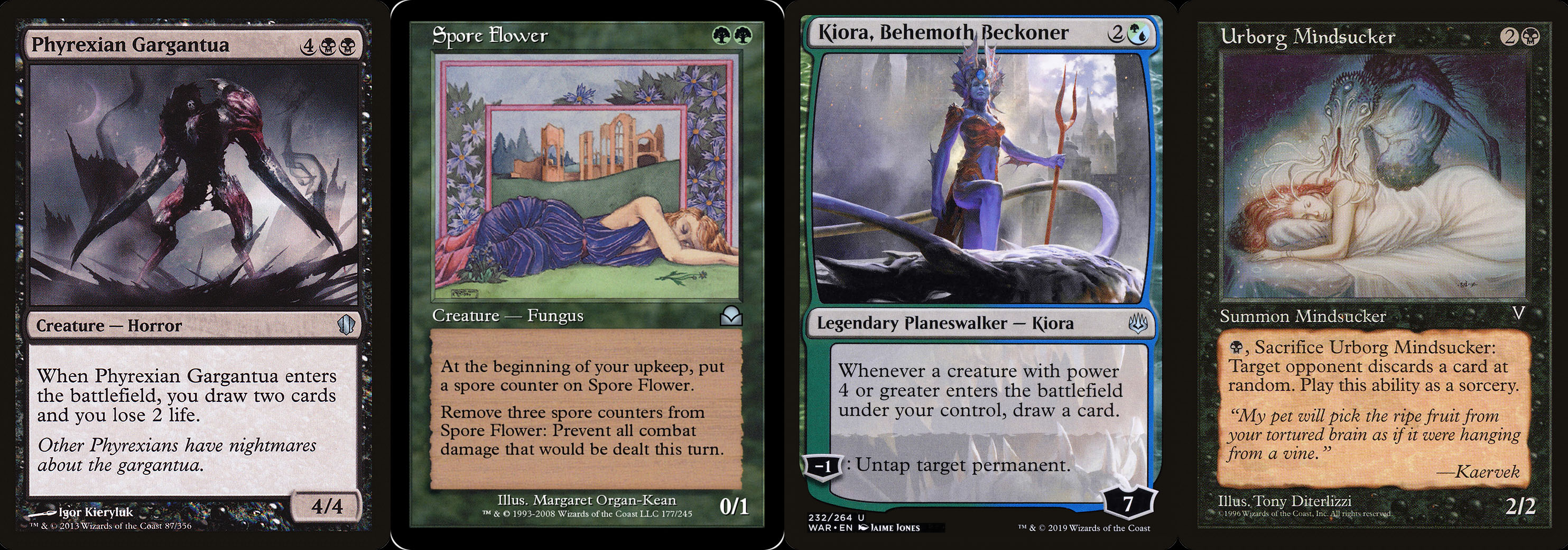#5. IMPROVISED RANDOM GENERATORS
Okay, we started by filling the map with every ounce of creative thought we had. Then we started recklessly stealing everything we could lay our hands on. But we’re still staring at empty hexes. Now what?
Now we need to get our creative juices flowing again by rapidly injecting fresh ideas that will break us out of the dried-out box our thinking is currently trapped in. There are a lot of ways to provide this stimuli.
For example, I’ve used Magic the Gathering cards to provide inspiration. In fact, you can use the MTGRANDOM website to generate a random Magic card. Let’s do that a few times and see what we get:
(click for large image)
So what I’m seeing here are some incredibly creepy constructs. Let’s say there’s a bunch of them. They’re harvesting spores from a crop of strange flowers that blossomed in the wake of an meteorite falling to earth. How do these constructs work? Well, looks like brains are being sucked out of people and placed into the constructs. Obviously Kjora there is in charge of the whole operation.
Combine that basic set up with an appropriate map from Dyson Logos and you should be good to go.
Alternatively, grab a random map from Dyson Logos first and then use the Goblin Ampersand to help you figure out what’s happening there by flipping to two random pages in the Monster Manual.
Another option is to repurpose random encounter generators. Sadly, this is a tool lacking in 5th Edition, but older editions include comprehensive generators that can be used (and a variety third-party options can be found).
For example, using the generators found in the 1st Edition of AD&D:
- Roll 1d8 to determine a column on the “Sub-Arctic Conditions” encounter table. I roll a 6, so the result is “Mountains.”
- Roll 1d100 with a result of 65. That’s a giant owl. According to the 1st Edition Monster Manual, giant owls appear in groups of 1d4+1. I roll and generate a group of five owls.
- Giant owls have a treasure type of “Q x 5, X.” I roll on those treasure tables and I get 1 miscellaneous magic, 1 potion, and 1 gem. Rolling on the sub-tables, I get a black pearl (500 gp), a potion of human control, and an amulet of life protection.
Okay, the hex I’m looking at is in the Old Forest, so let’s try something like this:
N7 – TREE OF THE ELDER OWL
A giant tree, over 80 feet wide at its base and towering several hundred feet in the air. Around the base of the tree are a number of strange carvings, intermixed with primitive pictures of owls.
CALL OF THE OWL: Anyone performing an owl call near the base of the tree will cause a hidden door to open, allowing passage into the hollow center of the trunk.
COUNCIL OF OWLS: Within the tree, four giant owls sit on perches. For an appropriate tribute, these owls can each cast augury once per day.
UPPER EYRIE: For a much larger tribute, the Council will have the supplicant remove their arms and armor. Then one of the owls will clutch them by the shoulders and fly them to the upper eyrie where they will be placed before the Elder Owl.
THE ELDER OWL: The left eye of the Elder Owl has been replaced with a black pearl (500 gp) and he wears an amulet of life protection. The Elder Owl will answer questions as per a commune spell, but he is also completely enamored with physical beauty: If someone of particular beauty (Charisma 16+) presents themselves, he will use his potion of human control in an attempt to enslave them.
#6. SPIN-OFFS
Regardless of how you’re stocking a hex, you should keep your mind open to other locations that the current hex suggests.
For example, you’ve got a necromancer in a crystalline spire who’s served by a bunch of goblins he’s charmed by writing arcane runes on the insides of their eyelids and then sewing their eyelids shut. Where’d he get the goblins from? Maybe there’s a village of them living nearby. They protect a tree that bears a single, bright red fruit each year. The fruit has magical properties and each year the necromancer comes to claim the fruit and take away goblin slaves.
Or you’re keying a grotto that a bunch of bandits are using as a hideout. Turns out these bandits have longbows of remarkably high quality. This is because they’re trading with a one-eyed troll who lives in a cave that can only be accessed through a green crystal which thrusts up through the forest floor: Lay your hand upon the crystal, say the magic password, and the crystal becomes intangible. The troll is a master bowyer.
#7. WALK AWAY
Finally, be willing to walk away from the project and take a break: Watch a TV show. Read a book. Flip through some unrelated game manuals. Power up the PS5.
Give your brain a chance to breathe and your creative batteries a chance to recharge.
This is not, by any stretch of the imagination, a comprehensive catalog or definitive technique for keying a hexcrawl. It’s just stuff that’s worked for me while keying hexcrawls.














Thanks for pointing out MTGRandom, it’s a really great inspiration tool.
Btw, 5th edition does have a random encounter generator by terrain and tier in Xanathar’s Guide to Everything.
For random 5e encounters, I’m a big fan of the donjon tools, e.g.: https://donjon.bin.sh/5e/random/#type=encounter
very useful tips, thank you!
I was wondering how many and which hooks do you recommend to start a hexcrawl? is a generic one enough (here are unexplored lands, have fun) or is better to give some more specific ones (here is an abandoned mine, somewhere in the mountains it is said there is an old temple, etc)?
@Percio: I’ll be doing a full post on scenario hooks at some point.
If you’ve got a group completely new to hexcrawls, I recommend:
1. Giving them at least 3 rumors/hooks, preferably aimed in different compass directions. You want their first impression of the campaign to be “you choose where you want to go.”
2. Also make sure to clearly spell out the default action: “If there’s no specific place you want to go, you can always pick a random direction and start walking. The whole point is to discover the cool stuff that’s out there!” This further emphasizes that they’re free to choose and explore this world however they want.
As you’re designing hexes, you might think, “This would be a cool rumor people could hear about this location.” Immediately write that down in your rumor pool.
To generate a generic rumor (either while stocking a rumor table or during play), just:
1. Pick a random hex.
2. Look at what’s in it.
3. What rumor could the PC have heard about that?
For example, if you’re working with a 10 x 10 grid, just roll 2d10 and cross-reference the hex.
Sometimes this won’t. (Because it’s a hidden/forgotten location that it doesn’t make sense for a rumor to exist for; or just because you want the PCs to be surprised when they find it.) Double-check those to see if the denizens of the location could be the subject of the rumor (“there are reports of red-skinned goblins in the Old Forest”). But if it doesn’t work (or if you just can’t think of a good rumor), that’s fine: Roll another random hex.
For example, if I randomly picked the hexes in Part 1 of this series:
B4. Red Ruth’s Lair. There’s a hag living in the bone brambles north of the Ashlands. If the PCs makes an Arcana check, they’d realize that she’d have a heartstone.
K13. Ruined Temple of Illhan. Some triceratops herders were saying that they saw some sort of ruined building west of Old Way Inn.
B5. Bone Crater. There was a huge explosion south of the Alvsrkaema caravanserai.
N15. Recent Forest Fire. There was a forest fire in the Old Forest.
C2. Wyvern Shaft. There have been sightings of a wyvern flying southwest of Caerdheim. It’s been getting closer town and could pose a threat to the loggers soon.
F15. Skull Rock There’s a huge obelisk made of gold that lies six days travel up the Kukulcan River. (False; but this could potentially lead the PCs up the Kukulcan, where they’ll encounter this location)
You can spin these out on demand pretty easily.
Wait, 5e really doesn’t provide random encounter tables? On one hand I’m not surprised as I feel that 5e is generally passively hostile to DM who want create their own scenarios, but on the other I find it extremely bizarre. I generally don’t run random “random encounters”, as I tends to prefer a more narrative focused approach, but I do use them in a similar way as suggested above. I use the table as a basis for building my encounters and slot them as the narrarive allows. If the players are crossing the desert, I use the tables to generate a set of potential encounters and figure out how they could fit together as nodes in a mini-narrative for the story of the desert as well as the wider narratives of the overall game and individual players. There’s a bit of wasted prep I suppose but in terms of overall time, but a lot less than without the tables as a basis.
@Justin thanks! I will be waiting for the post on hooks with great interest
@Michael I distinctly remember there being random encounter tables in the DMG. Unfortunately, just every other part of the DMG they are bland, low-effort, and absolutely unhelpful to new DMs. Ah, the wonders of entries like “2d6 goblins”, and “1d4 lions”.
In the DMG there is a section on making random encounter tables, but only one example table (for a magical forest if I remember right). If you want random encounter tables you’ve got to spend the extra money on Xanathar’s Guide to Everything.
A bit lazy in my view. I’m in agreement with Michael that 5e isn’t very DM friendly. There’s all sorts of examples from the lack of structure around loot and magic items, to stuff like the Assassin Subclass being given a poisoner’s kit proficiency that by the rules, doesn’t really do anything. Of course, I can homebrew all that stuff, but I did pay WOTC like 100 euro for the PHB and DMG so I don’t think it’s unreasonable to expect a more finished game than they presented.
More on topic, the old Hexcrawl series has been one of my favourites to come back and re-read. Super inspiring. I’m working away on my own hexcrawl and it’s pretty much entirely down to that series.
Some things I learned while hexkeying the island in _Ruins of Azlant_:
Don’t start at one end and try to work your way across the map. Try to think of some related things and fill in a couple hexes, then a couple elsewhere. This avoids having the part you did while you still had ideas being way better than the rest….
Pull apart a published module or AP for bits you can drop in as stand-alone hex details. This helps hugely; and you can anchor your own material around the drop-in bits.
Rivers are great. Ancorato had five rivers and they really helped organize the areas around them. The kingdom in _Kingmaker_ also had good rivers. I’d be loathe to hexkey (for kingdom building, anyway) without them. If you make the rivers hard to ford it makes fords/bridges important (assuming your PCs don’t have magic that makes this trivial) and maintains some “distance” areas without leaving the map.